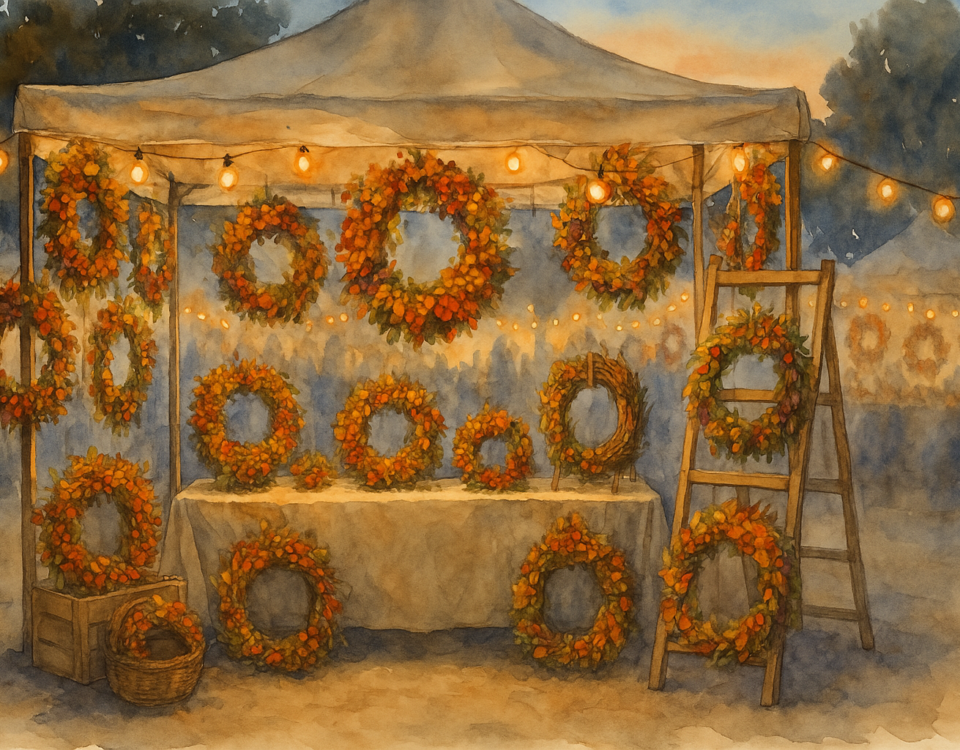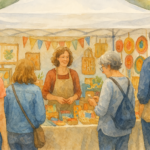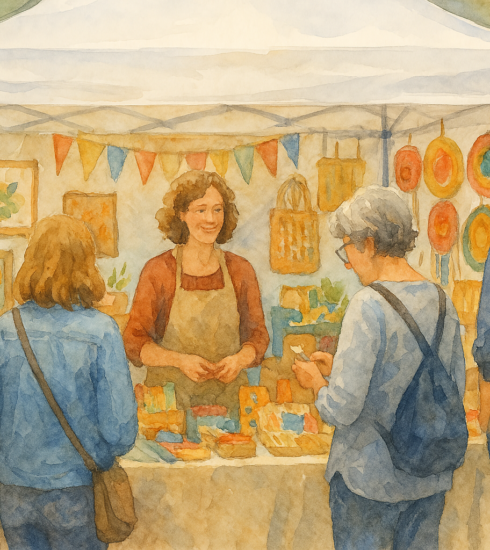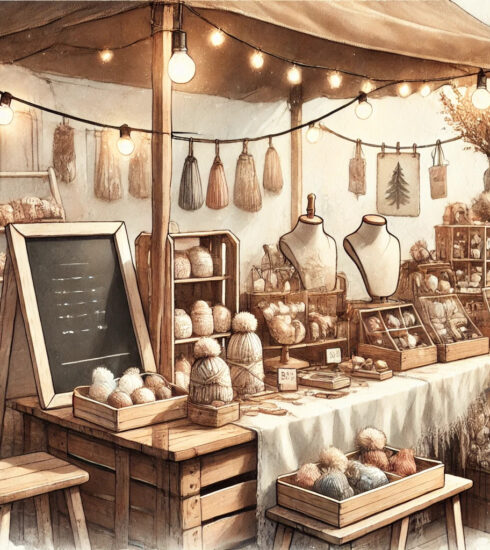Why Isn’t Anything Selling? Here’s a List of Good Sellers at Craft Fairs That Actually Move
Key Takeaways
| Concern | Quick Answer |
| What are good sellers at craft fairs? | Handmade jewelry, home décor, bath products, and personalized items consistently top the charts. |
| Do trends matter? | Yes—big time. Trendy items like macramé, resin jewelry, and eco-friendly goods move faster. |
| What price point sells best? | Impulse buys under $20 do well, but mixing in $30–$60 range items helps maximize sales. |
| Is booth setup important? | Extremely. Clear signage, custom options, and display levels all influence buyer behavior. |
| Are people still into handmade? | Absolutely. But it’s gotta be useful, pretty, or personal. Bonus points for all three. |
| Is cash still king? | Nope. Accept cards or you’re missing out on sales. QR codes help build your following too. |
This post contains affiliate links. If you purchase through these links, I may earn a small commission at no additional cost to you. Your support helps keep this site running—thank you!
Why Are Some Booths Swamped and Others Empty?
You’re standing behind your carefully arranged table. You’ve made everything yourself. It looks good. But barely anyone stops. And when they do? They compliment it… then walk away. No sale.
Meanwhile, two tables over, someone’s selling tiny handmade earrings and they can’t bag them fast enough. What’s going on?
Here’s the short answer: Some items are just good sellers at craft fairs. Others look cute but don’t convert. If you’re making what you love, but not what they buy, you’re probably gonna sit there wondering what you’re doing wrong.
Let’s break this down real simple. What do people at craft fairs actually buy? What are good sellers at craft fairs?
- Stuff they can afford easily
- Stuff they can carry around all day
- Stuff that feels personal, useful, or makes them go, “That’s cute, I want that now.”
Now, let me touch on each category. What works. What doesn’t. And why.
1. Home Décor That Feels Like a Find
You know what people think they want? Big fancy furniture. You know what they actually buy? Small things that fit in a tote bag.
Home décor sells well when it’s small, stylish, and easy to picture in their living room or kitchen. That’s it. Doesn’t need to be deep. Just needs to feel like a quick win.
What Works:
- Macramé Wall Hangings
They’ve been “in” for years. Still are. Especially neutral tones or boho vibes. Bonus if you add dip-dye, beads, or fringe. - Seasonal Wreaths
Fall leaves, Christmas, summer florals—people love swapping them out. Great repeat customers if you do seasonal fairs. - Hand-Painted Signs
Anything that says bless this mess, dog hair is my glitter, or kitchen open 24/7—these still sell. Especially with rustic wood. - Mini Rattan Shelves
Sounds random. But if it fits a tiny plant or keys? Boom. You just made a sale.
People wanna buy something that feels like a fun home upgrade. Not a chore to figure out how to hang or clean.
Quick Tips:
- Keep it lightweight
- Include hanging hardware or display options
- Stay on trend—neutral tones, fluted textures, soft wood grain
2. Jewelry That Looks Custom (But Isn’t That Hard to Make)
Jewelry isn’t just a good seller at craft fairs—it’s THE seller. But not all jewelry moves. That wire wrap necklace with 3 crystals and a butterfly charm? Might sit all day. While the girl next to you sells out of her $15 stud earrings.
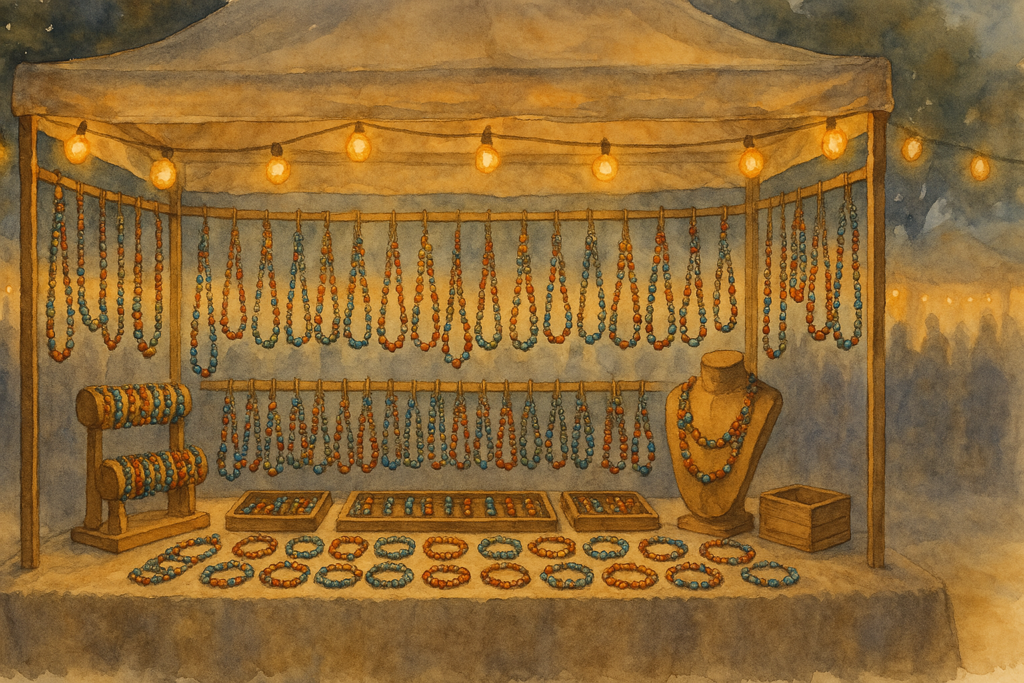
What’s Hot:
- Resin Studs or Dangle Earrings
Use botanicals, glitter, tiny clay pieces—seasonal colors help too - Polymer Clay Hoops
Lightweight. Modern. Doesn’t scream “handmade,” and that’s part of the charm - Beaded Bracelets with Cute Charms
Under $10 price point = add-on sale - Matching Sets for Mom & Daughter
Big during holidays, especially Mother’s Day or Christmas
Keep your prices tiered. One tray of $8 items, one tray of $20-ish pieces, a few $40+ one-offs. That mix gets people browsing and buying.
Packaging tip: Little jewelry cards. Craft paper or white. Clear branding. That’s it.
3. Personalized Items That Feel Like a Gift
Customization isn’t just fun—it feels exclusive. Like it was meant for them. And if you can make that happen in under 10 minutes? You’re printing money.
Easy Wins:
- Embroidery Hoops with names or dates
- Custom Tumblers or Mugs using vinyl or sublimation
- Wedding or Baby Signs with names and dates
- Minimalist Portraits from a reference photo (can be printed or sketched)
You don’t have to do personalization ‘on-site’. Have a QR code, offer shipping later, or let them fill out a short form on the spot.
Top Tip:
People LOVE to feel like they’ve found a thoughtful gift. These kinds of crafts are made to be gifted. Lean into that.
4. Eco-Friendly Swaps That Actually Work
Aesthetic sustainability. That’s what sells. Not preachy, not overengineered. Just cute stuff that makes them feel better about buying it.
What Moves:
- Beeswax Wraps in cute prints
- Wool Dryer Balls—especially bundled in 3s
- Reusable Snack Bags—bonus points for fun kid prints
- Compostable Kitchen Cloths
Make the benefits obvious at the booth:
- Save money
- Less plastic
- Looks way nicer than a Ziploc bag
If someone doesn’t get what it is in under 3 seconds, you’ve already lost them. Show it, label it, price it clearly.
5. Bridal Booths Are Sales Machines
Brides. Are. Ready. To. Buy. They’ve got budgets and Pinterest boards and are looking for ideas they haven’t seen before.
Bestsellers:
- Custom Hair Clips or Veils
- Flower Crowns or Everlasting Bouquets
- Wedding Table Signs or cake toppers
- Bridal Party Gift Boxes—offer bundles, not just single items
You don’t need to offer full wedding services. Just one cute accessory or giftable item can turn into a big order.
Tip:
If it looks nice in photos, it’ll sell. Set up a styled mock wedding display and boom—you just created a Pinterest moment that brings in foot traffic.
6. Bath Products They’ll Actually Use
These aren’t just “luxury” anymore. They’re comfort. Self-care. The I’m-stressed-so-I-deserve-this item of the day. Great impulse buys. Easy to gift.

What Always Sells:
- Soy Candles with clean scents
- Bath Bombs shaped like cupcakes or donuts
- Soaps with swirls, herbs, or even glitter
- Mini Body Butters in seasonal scents
Package matters. Cheap packaging = no sale. Go for simple, clean branding with kraft or black labels, or lean into color if that’s your thing.
Have testers. Let people sniff. That’s half the sale right there.
7. Artistic Creations That Feel One-of-a-Kind
Art doesn’t always mean a full canvas painting. People buy smaller, fun, unique items that make them feel like they discovered something cool.
What Works:
- Needle Felted Animals—especially pets or holiday stuff
- Mini Canvases—great at $10–$25
- Stickers & Prints—especially if you’ve got a niche (plants, crystals, animals, etc)
- Hand-Drawn Pet Portraits
You’re not trying to be in a gallery. You’re selling art that makes people smile. Or laugh. Or tear up a little. And that’s what sells.
Frequently Asked Questions About Good Sellers at Craft Fairs
How many items should I bring to a craft fair?
Plan for 3–5 units per item if it’s a one-day event. Bring backups for your bestsellers.
Should I focus on just one type of product or offer a mix?
Start with a focused niche, but offer a few accessory or impulse-buy items for variety.
Do I need to accept credit cards?
Yes. Get a simple card reader or use an app. Most people don’t carry enough cash anymore.
How do I price my items for craft fairs?
Use this rough guide:
- $5–$20 for impulse buys
- $25–$60 for mid-range
- $75+ for premium/custom work
Are digital products or printables good sellers at craft fairs?
Only if you offer instant downloads via QR or email signup—most shoppers come for physical items.
Do people actually care about eco-friendly packaging?
Some do, some don’t—but it never hurts. Just don’t let packaging raise your costs too much unless it adds value.
Traits That Make a Craft Fair Product a Top Seller
You can make the cutest candle in the world, or the most detailed macramé ever, but if it’s a pain to carry or overpriced… people walk away. Harsh, yeah. But true.
The stuff that actually sells—and keeps selling—tends to share a few things in common. Here’s what sets the winners apart from the “oh that’s nice” crowd.
1. It’s Light Enough to Walk Around With
Most buyers didn’t show up with a cart or backpack. They might have one tote bag, or worse, just their hands. If your item’s too bulky or awkward, even if they love it… they’ll “come back later.” (They won’t.)
Keep in mind:
- Smaller = easier to carry = more sales
- Avoid breakables unless they’re securely packed
- Make your packaging walk-away ready (tote, box, or sturdy wrap)
People shop with their eyes, sure. But they leave with their arms. If your item’s too big to juggle with a coffee and a phone, it’ll stay on the table.
2. Pricing That Makes Sense on the Spot
Impulse buys run the show. No one’s pulling out a calculator. They’re thinking in vibes, not budgets. Keep the math easy.
Price ranges that convert best:
- $5–$10 → Stickers, pins, tiny soaps, bracelet stacks
- $15–$30 → Earrings, candles, signs, wraps
- $35–$60 → Statement necklaces, bundles, art prints
- $75+ → Personalized or one-of-a-kind pieces
A mix of these lets you catch people at different buying moods. Some want a tiny gift. Others are ready to drop cash on something unique.
Pro tip: Round your prices. $19 feels cheaper than $20, but $20 is easier at a cash register. Up to you.
3. It Looks Trendy Without Needing Explanation
Trendy doesn’t mean viral. It means “this feels current.” If you’re selling something that was popular in 2012… you’ll notice. No one touches it.
So how do you stay relevant? Honestly, it’s not that hard.
Here’s where people get trend clues:
- Etsy’s trending page
- Pinterest boards
- TikTok craft hashtags
- Instagram reels
- Target’s home aisle
- Urban Outfitters gift section (oddly good for this)
Examples of “on-trend” in 2025:
| Category | Current Trend |
| Jewelry | Resin, organic shapes, mushroom charms |
| Home Décor | Rattan, fluted edges, warm neutrals |
| Art | Soft color gradients, celestial symbols |
| Eco Goods | Reusables in pastel or botanical prints |
| Bath Products | Earth-tone labels, minimal ingredients |
Does that mean you copy what’s trending? No. You just echo it enough to feel familiar. If your stuff fits what they’re already seeing online, they’re more likely to buy it in person.
Bottom line:
If someone’s asking “What is this?”—and not in a good way—you’ve already lost the sale.
Tips for Craft Fair Success Beyond the Product
You’ve got great items. They’re priced well. They’re trendy. But your booth? Kind of… just there. And that might be the problem. You can have the best products at the whole fair and still go home with half your inventory if you don’t set the stage right.
Craft fairs are part selling, part theater. Here’s what the seasoned sellers know—and most first-timers miss.
1. Your Booth Setup Is a Silent Salesperson
If your display doesn’t stop people from walking by, it doesn’t matter how good your stuff is. You’ve got about three seconds to grab someone’s attention. That’s it. They’re already halfway to the booth with the cinnamon churros.
Make it count:
- Vary your height—use risers, crates, or hanging racks
- Clear signage with prices (don’t make them guess)
- Use color blocking to catch the eye (group items by tone or category)
- Keep clutter away—organized ≠ boring
And yeah, test it. Set it up at home, take a pic, stare at it. Ask: would you stop here if you were walking past? If the answer is “not really,” change something.
2. Offer On-the-Spot Customization (or at Least the Illusion of It)
Even if it’s tiny—adding initials, picking colors, choosing scents—people love to feel like they’re getting something just for them.
Fast customization ideas:
- Stamp a name or date onto leather or metal tags
- Let people pick their bath bomb scents for a gift box
- Choose bead colors for a bracelet
- Offer “made while you walk” embroidery hoop art
- Write a personalized label for soap or candle jars
The trick is making it feel custom without it being a headache for you. Set boundaries. Use forms. Be clear about pickup time or shipping if needed.
3. Mix Cheap with Premium
Don’t put only $50+ pieces on the table. And don’t fill it with all $5 items either. You need a mix that works like this:
| Tier | Type | Why it works |
| Cheap ($5–$15) | Stickers, mini soaps, pins | Easy yes, no thinking required |
| Mid ($20–$40) | Jewelry, candles, signs | Main earners, big appeal |
| Premium ($50–$100+) | Custom stuff, art, bundles | Shows off skill, boosts average sale value |
The low-end gets foot traffic. The mid-range moves fast. The high-end makes it all worth it.
A $5 buyer today is a $60 buyer next time—if you wow them.
4. Make Paying Stupidly Easy
Don’t be the booth that loses a sale over a lack of tech. People don’t carry $40 in cash anymore. You need a card reader. It’s 2025. You have options:

- Square
- PayPal Zettle
- Venmo QR codes
- Apple Pay tap readers
Also—make it obvious that you take cards. Put the card reader in plain sight. Have a sign that says “We Accept Cards & Tap Payments.” Don’t make people ask.
5. Use QR Codes to Keep Customers Coming Back
Craft fair people might not follow you on Instagram or check your Etsy store after the event… unless you make it easy.
Here’s how you do that:
- Put a QR code on your table with “Follow me for new drops” or “Shop online later”
- Offer a discount if they follow you right now (10% off today’s sale)
- Build an email list for future sales (freebie if they sign up works too)
The craft fair doesn’t end when they walk away. Your next sale could be in a DM.
6. Pay Attention to the Vibe
Talk to people—but don’t hover. Smile. Say hi. Be chill.
If someone says “I’m just looking,” say “Totally cool. Let me know if you want to feel or smell anything!” Then give them space. Don’t hard sell.
Craft fairs are social. People are there to browse, chat, and maybe impulse-buy. Make your space feel like a good place to hang out for 30 seconds. That’s long enough to fall in love with something.
Great, let’s finish strong with the final content section before moving to the FAQ. Here’s the full next part:
Final Thoughts – What Makes a Product a Good Seller at Craft Fairs?
You can overthink this stuff. A lot of people do. They get stuck designing the perfect craft, pricing it just right, building a display that looks good enough to post on Instagram… and still walk away with barely enough money to cover their booth fee.
So what actually works?
Let’s strip it back.
The Formula for a Good Seller:
| Trait | Why It Matters |
| Looks cool at first glance | If they don’t notice it, they don’t buy it. |
| Easy to carry | No one wants to lug around a 3-foot sculpture. |
| Feels like a good deal | Not too cheap, not too steep. Just “worth it.” |
| Makes a good gift | People are always shopping for someone else. |
| Has a purpose | Functional + pretty = yes. |
| Looks on-trend | If it feels current, it feels right. |
A “good seller” isn’t just a product—it’s the combination of product + vibe + price + timing. It’s how it feels in their hand. What it reminds them of. Who they imagine giving it to.
That’s why one booth can crush it and the one next door can totally flop… even if the crafts are both great.
So, ask yourself:
- Would you buy this on a whim if you had $20 and a coffee in your hand?
- Would your best friend buy it for someone’s birthday?
- Would it still feel good to carry it around for 3 hours while walking through a parking lot?
If the answer isn’t “yes” at least once in there, it’s not the product. It’s how it fits into the moment.
And that moment? That’s what sells.
Frequently Asked Questions About Good Sellers at Craft Fairs
What are the easiest things to sell at craft fairs?
Easiest doesn’t mean cheapest—it means fastest to make, display, and explain. Think small, eye-catching, useful.
- Resin earrings
- Mini candles
- Beaded bracelets
- Stickers and art prints
- Soap bars
They’re low cost, don’t take up much space, and you can make them in batches.
How do I know if my craft will sell?
You don’t—until you test it.
But here’s a cheat list to help you guess:
- Do people ask to buy it when they see it?
- Have you sold a few already (online or to friends)?
- Does it solve a problem or work as a gift?
- Would someone pay $10–$60 for it without thinking too hard?
If you’re not sure, start with a small run. Take 5–10 of that product to your next fair. Watch how people react. Then decide.
How many items should I bring to a craft fair?
There’s no one answer. It depends on your product type, event size, and pricing. But here’s a rough starting point:
- 3–5 of each variation (color, scent, style)
- Enough small items to fill a 6–8 ft table
- Extra of your bestsellers hidden behind the table
If it’s your first time, don’t overdo it. You don’t need to bring 400 items to make money. Better to sell out and look popular than look overloaded and not sell much.
Should I only sell handmade stuff? What about resale items?
Handmade wins at craft fairs. That’s why people go. But some fairs allow resale items if they’re clearly labeled or enhanced (like printed designs on mugs, curated bundles, etc).
Always check the event rules. Some shows are strict—only handmade. Others allow some flexibility.
What about digital downloads or printables?
They can work, but they’re harder to sell at a physical event unless:
- You offer instant delivery via QR code
- You display samples in print
- You bundle digital with something physical (like a print + download pack)
Most craft fair shoppers want something they can touch, gift, or use right away.
Do I need a business license or tax ID to sell at craft fairs?
Sometimes, yeah. Depends on your state, city, and the event rules. Some craft fairs are casual. Others require:
- A sales tax permit
- Proof of business registration
- Liability insurance
Pro tip: Email the organizer and ask. Don’t guess. You don’t want to be turned away the morning of the event.
Do personalized items sell better than ready-made ones?
Yes. But only if it’s easy to understand, fast to do, and doesn’t slow down your booth.
People love custom:
- Names on ornaments
- Initials on leather keychains
- Personalized baby gifts
- Custom scents or labels
Just be clear about wait times or pickup options.
Should I accept Venmo, PayPal, or card payments?
Yes. All of the above if you can. Cash-only is risky these days. You’ll lose sales.
Set up:
- A mobile card reader (like Square or Zettle)
- QR codes for Venmo/PayPal
- Clear payment signage
Some people still use cash. Most swipe or tap. Meet them where they are.

